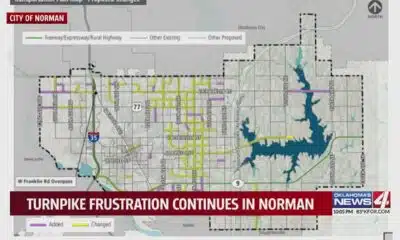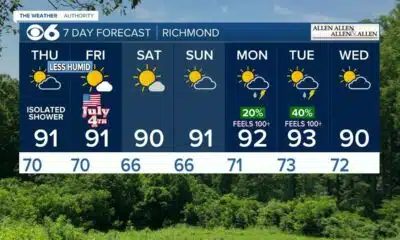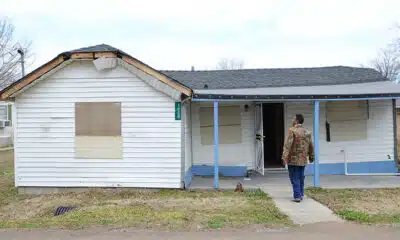News from the South - North Carolina News Feed
VP Kamala Harris, former President Donald Trump await 2024 Election results
SUMMARY: Vice President Kamala Harris will spend election night at Howard University, while former President Donald Trump and his supporters are in Palm Beach, Florida. Trump, who voted today, is again casting doubt on election integrity, claiming premature leads before results are in. His campaign, launched 720 days ago, will culminate in a marathon rally across three swing states, with unclear plans for a public address tonight. Meanwhile, Harris is in DC engaging in radio interviews, emphasizing the importance of every vote. She reflects on her first campaign experience at Howard and has been actively campaigning in crucial battleground states like Pennsylvania.
Former President Trump and his supporters will watch the results on Tuesday from Florida. Meanwhile, Vice President Harris will spend election night at Howard University in Washington, D.C.
More: abc11.com
Watch: https://abc11.com/watch/live/11065013/
Like us on Facebook: https://www.facebook.com/ABC11/
X: https://twitter.com/ABC11_WTVD
TikTok: https://www.tiktok.com/@abc11_eyewitnessnews
News from the South - North Carolina News Feed
AAA travel forecast: Lower gas prices, hit the roads early
SUMMARY: Millions of Americans are expected to travel this July 4th holiday, with Sunday and today being the busiest driving days. AAA estimates a record 61.6 million people will hit the road, urging travelers to leave before noon to avoid heavy traffic between 12 p.m. and 9 p.m. Gas prices offer relief, with summer prices at their lowest since 2021. In Raleigh, gas averages around \$2.93 per gallon, slightly above the state average. Prices in Wilmington and Asheville are about \$2.91 and \$2.90, respectively. Statewide, gas prices have recently decreased by several cents.
Wednesday is the busiest day of road travel before the July 4 holiday, according to AAA.
News from the South - North Carolina News Feed
Population loss in Western NC after Helene expected
In the aftermath of Tropical Storm Helene, some in government and the news media were sounding the alarm on the prospect of population loss in affected areas of the state. The fear that there would be a mass exodus from the North Carolina mountains was contagious.
The storm’s effect on the population will likely not be as dramatic as some imagined, but that doesn’t mean nothing has changed. It’s hard to say, nine months out, what to expect as the situation continues to develop.
But some clues have come into focus.
[Subscribe for FREE to Carolina Public Press’ alerts and weekend roundup newsletters]
State demographer Mike Cline thinks that, in the best-case scenario, the region will lose about 5% of its displaced population. The worst-case scenario could result in population loss as high as 35% among those who have been displaced.
Two factors affecting population were already in play. Families were being priced out of Western North Carolina — and the population has been aging.
Then came Helene. Some lost their homes and were forced to leave. They often had no choice. Some evacuated and never came back. People lost loved ones, pets, cars, businesses and so much more that had tied them to the area.
While most people who left their community will take up residence somewhere else in Western North Carolina, according to Cline, some won’t. Those who do return are likely to be older and have more financial resources than those who do not.
On the other hand, many, many people have stayed put and appear likely to remain where they are.
“When you have a disaster, people want to know immediately what is happening,” Cline told Carolina Public Press. “Most studies show that 65% to 95% of people, depending on the disaster, will return within six months to a year.
“But the data is limited. Most of Western North Carolina’s population live in unincorporated communities or very small towns. When you have a smaller population, it’s harder to track.”
But that doesn’t stop him from trying.
His office formed an ad-hoc subcommittee to meet and discuss the issue of population change post-Helene. They look at housing permits, demolition rates, rehabilitated properties, school enrollments and surveys of local governments.
From there, they can start to get a sense of how many people were displaced and unlikely to return. But they are wary to release anything official until more robust data is available.
Changing population migration patterns
The storm may deter or delay people who were thinking of moving or retiring to Western North Carolina.
“Are the people who were planning to move here actually going to move now?” Cline asked. “That’s where I think the greatest impact in terms of future growth or change will be.”
The region was seen as something of a “climate haven” before Helene, a place where one could be safe from extreme temperatures, sea-level rise and natural disasters, according to Mitchell County resident Lori Gilcrist.
The mountains have lost that status, she says. The chance of something like Helene happening again may decrease the region’s popularity.
It also could be the final straw for someone who was thinking of leaving the region already.
But Gilcrist, for one, said she is not going anywhere.
One factor Cline talks about is the “rootedness” of the region. Even though it’s a popular retirement destination, some families have been there for generations, folks born and raised and still living in the same communities their great-grandparents did.
That Appalachian rootedness may insulate the region from extreme population loss.
Academic aftershocks
But for some populations, like the student population at Appalachian State University in Boone, for example, that rootedness is not really a factor.
“There were a lot of students who had housing problems and real psychological trauma, during and right after the event,” said Colin Kelley, a professor of climate science at App State. “Many had to go home to help their families or deal with their own problems.”
In the Henderson County school system, enrollment dropped by 283 students after the storm.
That number includes families who left the region completely, relocated to a different school district or withdrew their children from school while dealing with the aftermath.
In Buncombe County, eight schools experienced “large losses” in the student body, meaning losses of 20 students or more.
But school officials in Haywood and McDowell County say enrollment numbers have been steadily declining for years, so it’s hard to say how different things would have looked if Helene had not happened.
That’s the prevailing feeling in the Haywood County government as well.
“It’s really difficult to quantify population changes and even more so to attribute any shifts directly to Helene,” said Dillon Huffman, the public information officer for Haywood County.
“From a local government perspective, I don’t know how we associate anything as a direct result of the storm. In fact, I would venture to say that Haywood County has grown in terms of overall population over the past year. One indicator we keep an eye on is building permit activity, which remains strong.
“We won’t have official Census data for another five years, and we’re only nine months out from Helene — it’s tough to establish meaningful trends in such a short window.”
Clarification: This article has been updated to show that the predicted 5% to 35% population loss for Western North Carolina is among just the displaced portion of the population and not the overall population. An earlier version of the article was unclear on that point.
This article first appeared on Carolina Public Press and is republished here under a Creative Commons Attribution-NoDerivatives 4.0 International License.
The post Population loss in Western NC after Helene expected appeared first on carolinapublicpress.org
Note: The following A.I. based commentary is not part of the original article, reproduced above, but is offered in the hopes that it will promote greater media literacy and critical thinking, by making any potential bias more visible to the reader –Staff Editor.
Political Bias Rating: Centrist
This article provides a factual and balanced report on the population impacts following Tropical Storm Helene in Western North Carolina. It relies on data from multiple sources, including state demographers, local officials, and academics, presenting varying perspectives without editorializing or advocating for a specific political viewpoint. The language is neutral, focusing on observed effects and uncertainties without emotional or ideological framing. There is no clear alignment with partisan or ideological stances, reflecting an objective, data-driven approach typical of centrist reporting.
News from the South - North Carolina News Feed
Republicans rewrote the US Senate megabill in its last moments
SUMMARY: Senate Republicans finalized a major bill with last-minute changes addressing Medicaid cuts, rural hospital funding, SNAP costs, and clean energy tax credits. The rural hospital fund was doubled to \$50 billion and payments accelerated to 2026 to offset Medicaid cuts. SNAP provisions allow certain states with high payment error rates to delay sharing program costs until 2029. A clean energy excise tax on solar and wind projects was removed before the vote, while deadlines for energy tax credits were extended to encourage investment. Despite changes, Senators Collins, Tillis, and Paul opposed the bill; Vice President JD Vance broke the tie.
The post Republicans rewrote the US Senate megabill in its last moments appeared first on ncnewsline.com
-
Mississippi Today7 days ago
Defendant in auditor’s ‘second largest’ embezzlement case in history goes free
-
News from the South - Georgia News Feed6 days ago
Are you addicted to ‘fridge cigarettes’? Here’s what the Gen Z term means
-
The Conversation6 days ago
Toxic algae blooms are lasting longer than before in Lake Erie − why that’s a worry for people and pets
-
News from the South - Tennessee News Feed7 days ago
5 teen boys caught on video using two stolen cars during crash-and-grab at Memphis gas station
-
Local News7 days ago
Mississippi Power shares resources and tips for lowering energy bill in the summer
-
News from the South - Kentucky News Feed7 days ago
Error that caused Medicaid denials has been corrected, says cabinet in response to auditor letter
-
News from the South - Georgia News Feed7 days ago
GOP mega-bill stuck in US Senate as disputes grow over hospitals and more
-
News from the South - South Carolina News Feed5 days ago
Federal investigation launched into Minnesota after transgender athlete leads team to championship











































